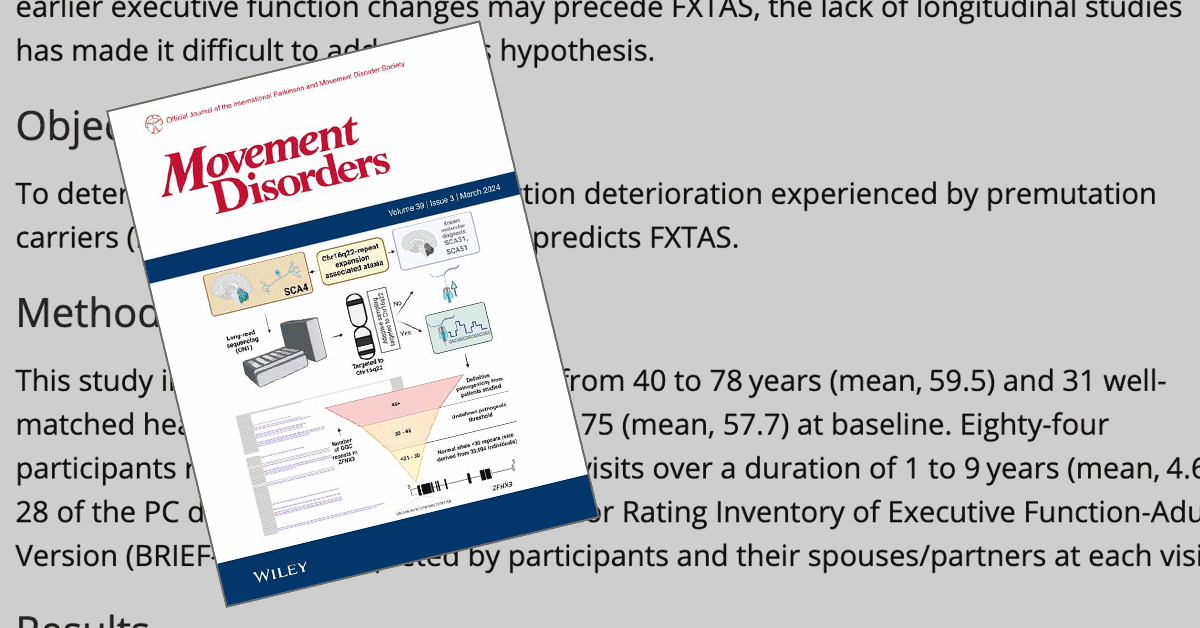Introduction
Fragile X-associated tremor/ataxia syndrome (FXTAS) is a neurodegenerative disorder that was discovered in 2001 after clinicians noted a pattern of neurological symptoms present in older (primarily male) grandparents and parents of persons with Fragile X syndrome (FXS).[1] FXTAS is caused by a trinucleotide CGG repeat expansion in the premutation range (55–200) in the FMR1 gene. It is an inherited neurodegenerative disorder that typically affects adults over 50 years old and is associated with a spectrum of neurological and medical symptoms. FXTAS affects men with more frequently than women because of the protective effect of the second X chromosome in women.
Approximately 1 in 150–300 women and 1 in 400–850 men in the general population are carriers of an FMR1 premutation sized repeat.[2, 3] Among premutation carriers, about 40% of males older than 50 years and 8%–16% of women older than 40 years develop FXTAS.[4, 5] However, the risk of FXTAS in any given individual is influenced by their CGG repeat size (a larger number of repeats increases the risk), sex (men are at greater risk), and age (symptoms are more common at older ages).[5, 6] In women, the activation ratio, or percentage of cells expressing the premutation allele, may also play a role.[7] Considering all of these factors and literature to date, we estimate that the lifetime prevalence of FXTAS in the general population is ~1 in 8000. This indicates that FXTAS is significantly less common than essential tremor or Parkinson’s disease in older adults.
Diagnosis and Recognition
Onset of FXTAS is typically in the early seventh decade, with mean age of onset of tremor and/or ataxia in men at approximately 61 years. Symptoms of FXTAS vary among individuals. Typically, they include progressive signs of tremor, cerebellar ataxia, parkinsonism, and cognitive decline, with specific impairments in executive functioning. Additionally, psychiatric disturbances, autonomic dysfunction, and peripheral neuropathies may be present. [4, 8]
The first neurological sign at onset is variable. Tremor appears to be the sign most likely to trigger evaluation from a health provider. Action tremor is most common, although many affected individuals may not be aware of its impact on their daily living activities. Mild, intermittent tremor may be present for years before the diagnosis. Rest tremor is less common, but can also be present, especially in patients who have more of a parkinsonism presentation. Almost all affected persons develop cerebellar gait ataxia as the disease progresses. Tandem gait is abnormal and unexplained falls occur in ~35–50% of premutation carrier men who are older than 50 years of age.[5, 9] Other impairments, including parkinsonism, sensory neuropathy, and weakness, contribute to the poor balance observed in FXTAS. However, cerebellar dysarthric “scanning” speech, oculomotor findings and appendicular ataxia are all less common in FXTAS than in other inherited cerebellar disorders. Although many affected patients have features of “classic” FXTAS, other neurological presentations, such as atypical parkinsonism, primary dementia, or neuromuscular abnormalities, can also occur as primary disease manifestations.
As the condition progresses, cognitive dysfunction such as executive impairment, memory deficits and eventually dementia may occur. These symptoms may influence intelligence, working memory, remote recall, information-processing speed, and temporal sequencing. Impaired executive function may lead to psychiatric and behavioral disorders as noted by increased anxiety, irritability, agitation, hostility, obsessive-compulsiveness, apathy, and depression.
Individuals with FXTAS usually have abnormal MRI findings, such as white matter lesions, generalized brain atrophy, or increased T2 signal in the middle cerebellar peduncles (MCP sign), pons, periventricular region, or the splenium of the corpus callosum (CCS sign).
Of note, about 20% of women with the FMR1 premutation develop Fragile X-associated primary ovarian insufficiency (FXPOI). Women with FXPOI do not have an increased risk of FXTAS compared with women who carry premutations and have normal ovarian function. In addition, classic FXTAS phenomenology and imaging abnormalities have been reported in FMR1 gray zone carriers (41–54 CGG repeats) and in those with a full mutation that is unmethylated or mosaic with a premutation.[10, 11, 12, 14] However, FXTAS cases with repeat sizes outside of the premutation range are rare.
Table 1 outlines the clinical diagnostic criteria on which FXTAS is based. Three levels are used to indicate the confidence of a diagnosis given symptom manifestations at the time of evaluation.
Table 1. FXTAS Diagnostic Criteria in Carriers of a FMR1 Premutation [15]
| LEVEL OF CONFIDENCE | |
| Definite | Presence of 1 major radiological sign plus 1 major clinical symptom |
| Probable | Presence of either 1 major radiological sign plus 1 minor clinical symptom or has the 2 major clinical symptoms. |
| Possible | Presence of 1 minor radiological sign plus 1 major clinical symptom |
| SYMPTOM CLASSES | |
| Radiologic: | |
| Major | MRI white matter lesions in MCPs or CCS and/or brain stem |
| Minor | MRI white matter lesions in cerebral white matter |
| Minor | Moderate to severe generalized atrophy |
| Minor | MRI white matter lesions in the splenium of the corpus callosum |
| Clinical: | |
| Major | Intentional tremor |
| Major | Gait ataxia |
| Minor | Parkinsonism |
| Minor | Moderate to severe short-term memory deficiency |
| Minor | Executive function deficit |
| Minor | Neuropathy in lower extremities |
| Neuropathology: | |
| Major | FXTAS intranuclear eosinophilic inclusions that are ubiquitin positive |
Testing for FXTAS
A diagnosis of FXTAS is confirmed by testing for a premutation-sized CGG repeat expansion in FMR1 DNA in patients with a suggestive constellation of symptoms. Findings from a brain imaging study (primarily magnetic resonance imaging (MRI)) can aid in the diagnosis. Table 2 outlines who should be tested for an FMR1 premutation given their presentation of neurological symptoms.
Table 2. Guidelines for Whom to Test for FXTAS
| Cerebellar ataxia | If is 50 years or older and the cause is unknown |
| Action tremor | If is 50 years or older and the cause is unknown; AND if also has cerebellar ataxia, parkinsonism, or dementia |
| Dementia | If is 50 years or older and the cause is unknown; AND if also has cerebellar ataxia, parkinsonism, or action tremor |
| Multiple system atrophy cerebellar subtype | Especially if a prolonged course |
| Some FXTAS signs + family history of fragile X-associated disorders or related symptoms | Patient who has symptoms of FXTAS (e.g., action tremor, cerebellar ataxia) AND has a family history of ovarian insufficiency (including infertility) OR congenital intellectual disability or Autism Spectrum Disorder; family history of individuals diagnosed with fragile X syndrome, FXPOI, or FXTAS; family members who have been diagnosed with anFMR1mutation. |
Current Treatment Guidelines
The goal of therapy for FXTAS is to reduce symptoms and eventually to slow the progression of disease. Management of FXTAS is complex and involves appropriate follow-up by an adult neurologist. It is also important to evaluate other potential causes of dementia such as vitamin B12 deficiency, folate deficiency, and depression. Treatable causes of cerebellar ataxia should be considered in cases with significant gait symptoms. This typically includes testing liver and renal function, vitamin E, copper, thyroid function, autoimmune (SSA/SSB, ANA, Gad-65, Celiac), and paraneoplastic disorders.[16] Reversible causes of neuropathy should also be considered, including diabetes, monoclonal proteins, and vitamin B12 deficiency. Additionally, individualized care regarding possible adverse events from medications is essential. Referral to physical therapy or rehabilitative medicine, urology, genetic counseling, and social work should be considered.
Currently, intervention is limited to symptomatic therapy as there have been no effective medications based on controlled clinical trials. Treatment recommendations are based on anecdotal reports and knowledge of other disorders that are similar to FXTAS.[4, 9] For example, action tremor and parkinsonism in FXTAS may respond to medications used for essential tremor and Parkinson disease, respectively. Action tremor may respond to B-blockers, primidone, and topiramate. Deep brain stimulator surgery can be considered for tremor. Unilateral surgery with non-traditional targets may be less likely to worsen ataxia or cognition after surgery. Medications for cerebellar dysfunction can be considered, such as amantadine, buspirone, varenicline, riluzole, or ampyra, although none have proven efficacy in FXTAS or other inherited ataxias. Treatment of psychiatric symptoms with selective serotonin inhibitors may be effective, although patients need to be monitored for worsening of balance.
It is important to note that treatments for FXTAS should be individualized as symptoms vary in every individual. Treatments should also be approached globally utilizing medications, psychological counseling, rehabilitative interventions such as speech, occupational and physical therapy, and gait training. Consideration should also be given to supportive services and counseling for the family. Specialty fields helpful in the care of individuals with FXTAS include neurology, psychiatry, psychology, rehabilitation, urology, cardiology, and movement disorders neurology.
Genetic counseling for individuals with FXTAS and their family members is recommended, due to the inheritance of the X-linked FMR1 expansion mutation. All daughters of men diagnosed with FXTAS (i.e., confirmed to have a premutation sized CGG repeat) are obligate FMR1 premutation carriers. For women with FXTAS (again, with confirmed premutation sized CGG repeat expansions), each child will have a 50% chance of receiving the FMR1 mutation, with the potential of their premutation expanding to a full mutation (<200 repeats). The full mutation leads to Fragile X syndrome, the most common inherited form of intellectual and developmental disabilities and the most common known single-gene cause of autism spectrum disorder (ASD). The expansion to the full mutation depends on the size and number of AGG interruptions in the premutation allele carried by the mother.[17]
Finding Medical Care
How can I find a physician who is knowledgeable about FXTAS?
Fragile X Clinical and Research Consortium includes clinics treating FXTAS, or can provide information or referral to a neurologist or other physician with experience in caring for patients with FXTAS. You can also email us at treatment@fragilex.org.





